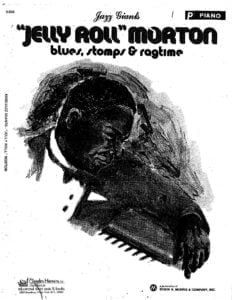Table of Contents:
Please, subscribe to our Library. Thank you!
Who wasJelly Roll Morton?
At the origins of jazz, reality and fantasy intersect to an indiscernible degree. And this is the case of Jelly Roll Morton, (New Orleans, October 20, 1890 – Los Angeles, July 10, 1941), whose real name was Ferdinand Joseph LaMothe. Born into a family of the Creole petite bourgeoisie of the capital of Louisiana, he began music since he was little.
In his teens he tried the harmonica, drum, violin, trombone, and guitar, until he finally decided on the piano. He carried out intense music theory studies and used much of his time to improve his piano technique for which he received classes from Tony Jackson.

After the death of his mother and the disappearance of his father, Morton lived with his godmother who ran a brothel in New Orleans and there he learned to play in public and carry a gun on his belt. In that environment, his youth was plagued by arrests, confinements in jail, several convictions for minor crimes and even an escape from prison.
In 1905, he worked as a pianist in the Storyville neighborhood, the center of all the slums and brothels in the city. After some successful composition, he tried his luck in Chicago and later in California, a city he visited when the San Francisco World’s Fair was being held.
He undertook a tour of the South with more failures than successes, and in 1917 he ended up in Los Angeles where he paired up with a fellow countryman from New Orleans and managed a hotel. In 1923, the opportunity came to him to demonstrate that if in his life he was a fraud, a little scoundrel and a trickster, in music he was honest, serious and rigorous. He discovered in Chicago that New Orleans jazz was played there.
In June of that year, his first recordings were recorded, a couple of songs fronting an irrelevant group. But a month later he recorded his first piano solos for the “Gennett” label, which began, until mid-1924, one of the three stellar moments of his record company.
The other two are the recordings in Chicago and New York, leading his “Red Hot Peppers” between 1926 and 1928, and finally the sessions for the North American Library of Congress in 1938, when Morton was already a living legend. Morton’s piano solos in 1923 constitute the best testimony of the transition between “ragtime” and jazz proper. The second date of his intense career began at the end of 1926, when his editor, Walter Melrose, got him a contract with the Víctor label.
Over the next nine months, with a group he called the “Red Hot Peppers,” he recorded sixteen pieces considered the best testimony of New Orleans jazz in its original state. In 1928, Morton left Chicago, where he spent the happiest period of his life, and moved to New York, the new center of jazz, and there he would discover that his music was no longer the most advanced. By 1930, his style was out of fashion and his attempts to jump on the bandwagon of new music (swing) failed. It was only in the late 1930s that he was rediscovered for jazz.
It was in 1938 when Morton was working as a pianist at “The Jungle,” a modest club in Washington, when he was recognized by Alan Lomax, a prestigious musicologist, who convinced Morton to carry out an ambitious musical project: confront him on piano alone, with a bottle of whiskey and a microphone, to record for the North American Library of Congress and reproduce the style of forgotten colleagues, and leave the most faithful testimony of his piano skills in an unrepeatable sound and artistic document. It was the swan song of his career.
Two years later, in 1941, with his health already very broken, Morton died in Los Angeles after an episode of asthmatic illness. Jerry Roll Morton and his “Red Hot Peppers” continued the main path of jazz undertaken by Joe King Oliver and later continued by Louis Armstrong and Duke Ellington.
